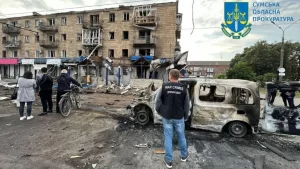Russia Launches Counteroffensive in Kursk Region Amidst Intense Fighting
3 min read

Russia’s defense ministry has announced the successful recapture of 10 settlements in the Kursk region, which were previously occupied by Ukrainian forces. This development follows a surprise incursion by Ukraine into the region last month. Ukrainian President Volodymyr Zelensky has acknowledged Russia’s counteroffensive, aligning it with Ukraine’s broader strategic plan.
According to Russian sources, their “Units of the North” reclaimed these settlements over a span of two days in the area around Snagost. This region lies on the western side of the territory that Ukraine had taken as part of its offensive, which began on August 6. The initial hint of a counteroffensive came from Chechen special forces commander Major General Apti Alaudinov, who reported significant losses among six Ukrainian brigades.
A Ukrainian officer in the Kursk region, who spoke described the situation as grim, noting that the counteroffensive had commenced west of Sudzha. The officer indicated that the ongoing battles are particularly challenging and currently not favorable for Ukrainian forces.
Ukraine’s offensive was initially aimed at diverting Russian attention from its advances in eastern Ukraine. Despite this, Russian troops have continued to capture villages in eastern Ukraine and are closing in on the strategic town of Pokrovsk. According to analysts from the US-based Institute for the Study of War, the scale and future impact of the Russian counterattacks remain uncertain, making it too early to draw definitive conclusions.
Reports from a Ukrainian brigade’s social media account indicated that Russian forces unexpectedly initiated their assault near Snagost, leading to continued clashes. Ukrainian forces have previously destroyed three bridges across the River Seym to prevent Russian advances, along with several temporary pontoon bridges. Despite these measures, there are reports suggesting that Russian troops have managed to cross both the Seym and smaller rivers as part of their counteroffensive.

Russian military expert Anatoly Matviychuk reported to the Moskovsky Komsomolets newspaper that over 100 square kilometers of territory had been reclaimed by Russian forces. He claimed that Ukrainian reinforcements and logistical supplies were now unable to reach the Kursk region.
The initial Ukrainian incursion into Kursk caught Russian military forces off guard, with Moscow surprised by the speed and ease of Ukrainian advances in towns such as Sudzha. Despite this, President Vladimir Putin remarked nearly a month later that the Ukrainian offensive had failed. He suggested that the Ukrainian attempt to provoke a response from Russia had not only failed but had inadvertently furthered Moscow’s primary objective of capturing the Donbas region, which includes the industrial areas of Donetsk and Luhansk.
Russian forces are reportedly just a few kilometers away from Pokrovsk and the nearby town of Myrnohrad, with fierce combat occurring around these locations. An overpass linking the two towns was destroyed overnight, and the Donetsk regional head reported that a water supply line to Pokrovsk had been cut, though the town still has access to several wells.
In a separate incident, the International Committee of the Red Cross (ICRC) reported that three of its staff members were killed while delivering aid in the Donetsk region. The ICRC condemned the attack as a war crime but did not specify the perpetrators, emphasizing the unconscionable nature of targeting aid distribution sites.
Additionally, a Russian drone strike on the northern Ukrainian town of Konotop, a critical hub for Ukraine’s Kursk campaign preparations, left 14 people wounded. The attack caused significant damage to apartment blocks and disrupted power supplies in Konotop, severely impacting the town’s energy infrastructure.